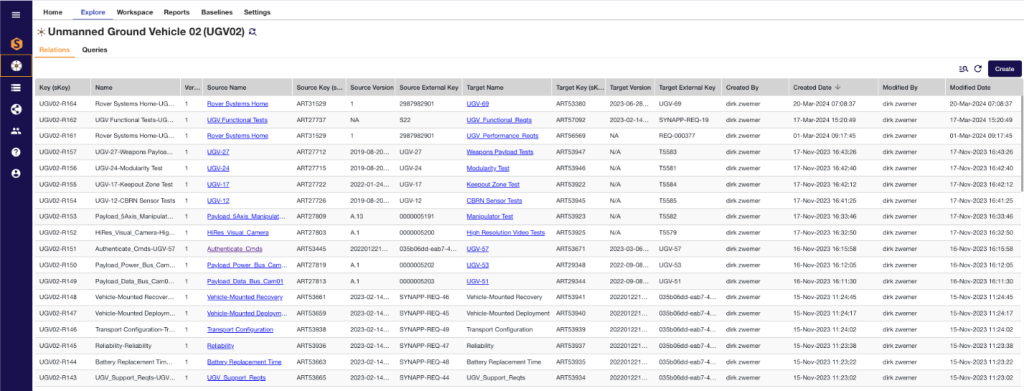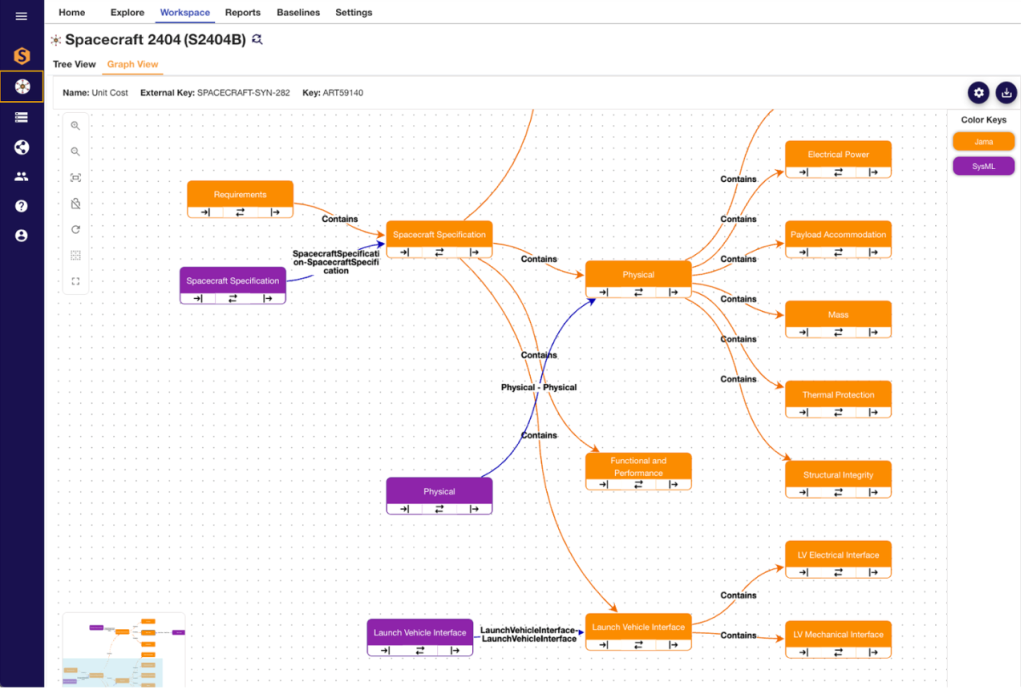As part of the release of Syndeia 3.6, we are publishing a series of blog posts highlighting the new features supporting practical implementation of digital threads in system development. Many of these center around Digital Thread Projects (DTP) and how users are able to access only those DTPs they have been authorized to view or edit.
But once a user has entered their DTP workspace, the range of reports and analytical tools available to them in the 3.6 Syndeia Web Browser has been greatly expanded. Among other capabilities, users can
- Browse the external repositories for data that should be part of the DTP
- Create relations to those artifacts within the active DTP
- View and navigate those relations within the active DTP
Using these capabilities, each user can help build the digital thread and use it going forward to see how their work impacts other work downstream and how changes upstream affect them.
In this post, we will review the pages under Explore and Workspace on the DTP Dashboard in the Syndeia Web Browser. Many of the features shown are carried over from Syndeia 3.5, but with a significant difference – only inter-model relations from the active DTP can be read, created, updated or deleted.

Figure 1 shows an example of the DTP Dashboard, Explore tab, Relations subtab, in the Syndeia Web Dashboard. It is a flat list of all the inter-model relations currently part of the active DTP. There are icons at the top right for Search and Refresh and a button to create a new inter-model relation. The Source and Target names representing the two ends of the relation may be live links, allowing the user to open that element in its repository’s native browser, if such is available. The user can also sort, filter and rearrange table columns by clicking on the three-dot ellipsis on the column headings.

Figure 2 shows an example of the Workspace tab. This is where a user may browse the contents of the underlying repositories through the Syndeia Cloud REST API, to decide what elements should be added to their digital thread.
The first column contains the list of repositories to which Syndeia Cloud has the potential ability to connect. The user can add additional repositories (if their global permissions allow). If they select a repository, its contents appear in a tree in the second column if they have the appropriate repository privileges. If the user does not have repository privilege, nothing appears in the second column except a warning message. However, the user may add or update repository privileges from this page.
Using the icons in the upper right corner, the user can
- View metadata about the selected element in the underlying repository (Details)
- Search using that repository’s native search capabilities (Search)
- View both intra-model relations to that element (inside its own repository) and inter-model relations that are part of the active DTP (Relations)
In Figure 2, that third report is shown opened on the right side of the panel. A requirement in Jama Connect is shown to have five intra-model connections to other Jama elements and one inter-model connection. In prior releases of Syndeia, inter-model relations from all DTPs would have been shown in the top table, but in Syndeia 3.6, only relations from the active DTP are shown and the Add (+) icon allows users to add relations only to that project.

The Digital Thread Explorer is an interactive graphical visualization that lets users trace out the digital thread from a starting element in real-time. In Figure 3, it has been launched (from the selected Jama requirement in Figure 2) and then expanded several times to show nearest and next-nearest neighbors. Again, we stress that inter-model relations from the active DTP only are displayed.
The Repositories page from the Syndeia 3.5 release is still available in the left Control Bar. It provides views similar to Figure 2 and Figure 3, but in Syndeia 3.6, only intra-model relations are shown. No inter-model relations can be viewed or created from this page.
In this post, we have shown how the combination of project, global and repository privileges can flexibly put limits on the ability of individual team members to view and change the digital thread. In the forthcoming posts, we will shift to entirely new capabilities in Syndeia 3.6 to view, analyze and document it. In Part 5, we will discuss the Reports page.
Other parts in this series:
- Syndeia 3.6 Release, Part 4: Digital Thread Project Browsing (This Post)
